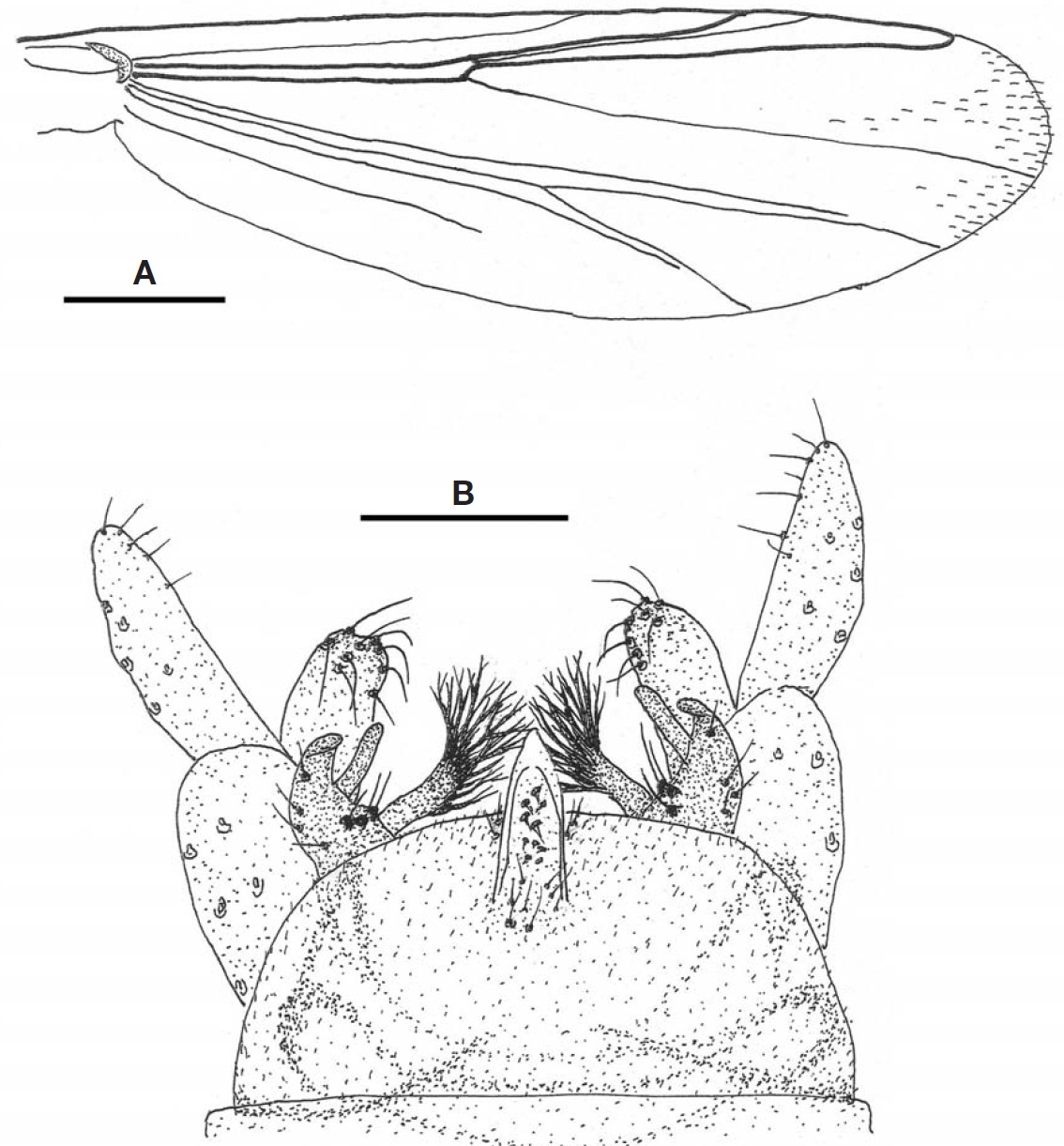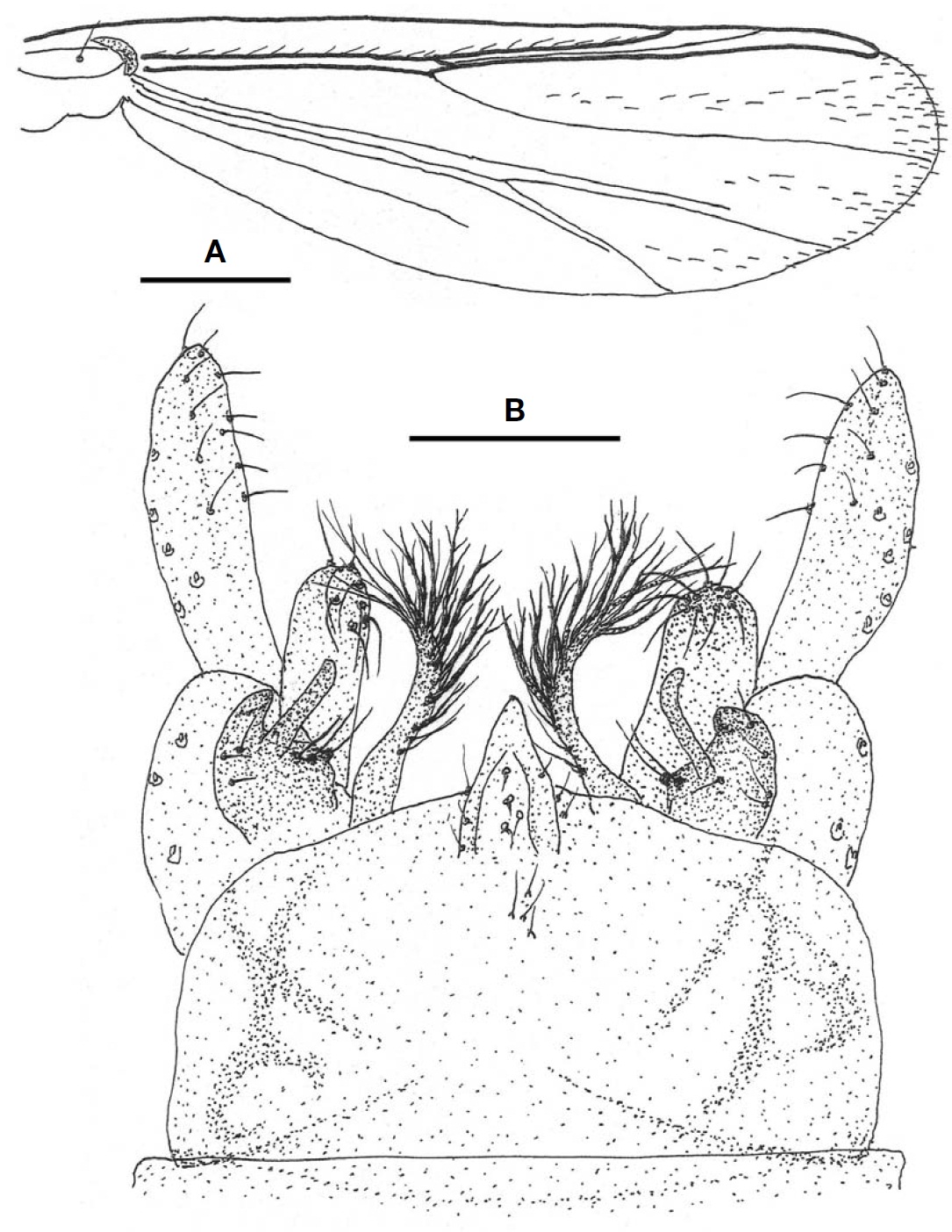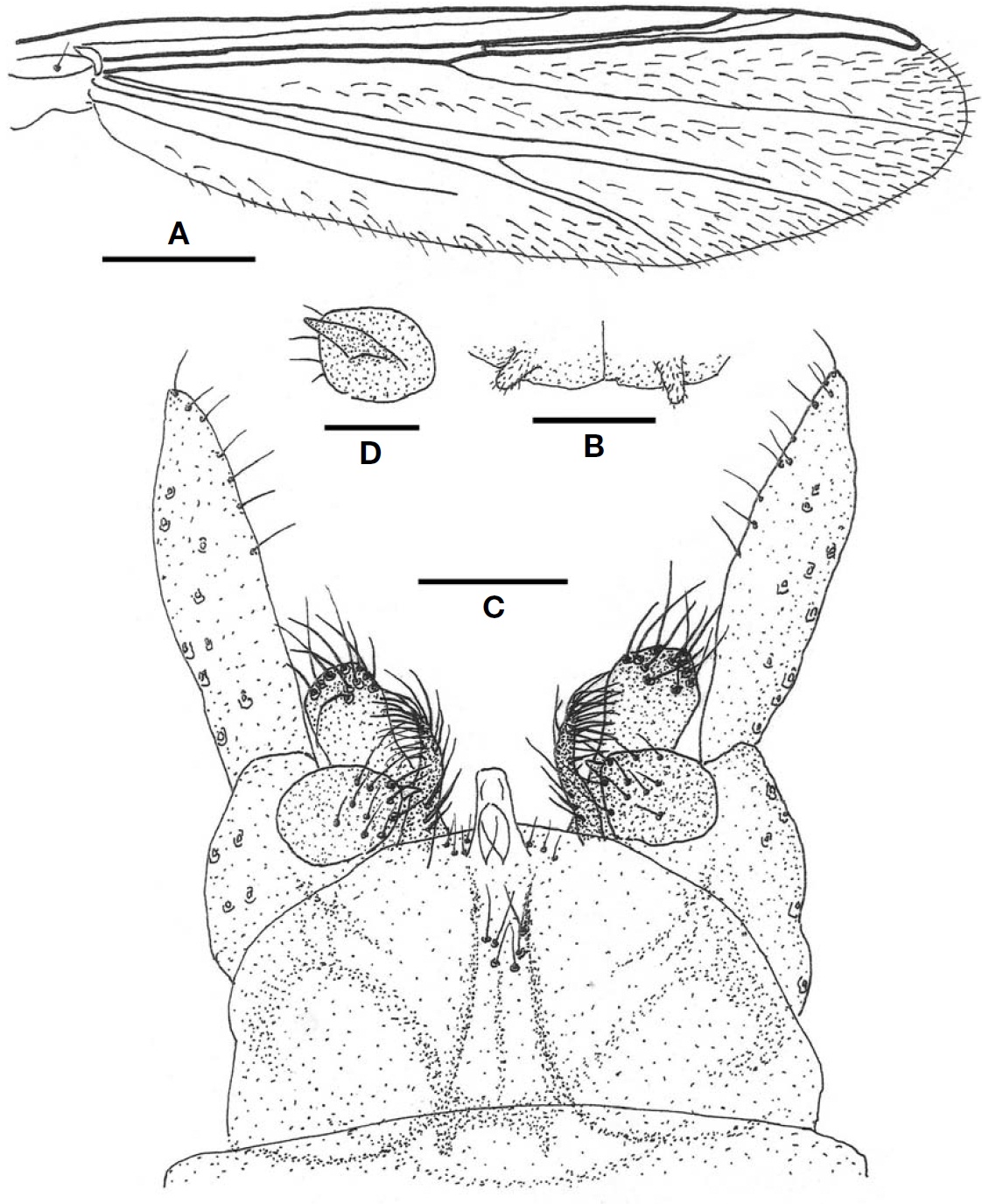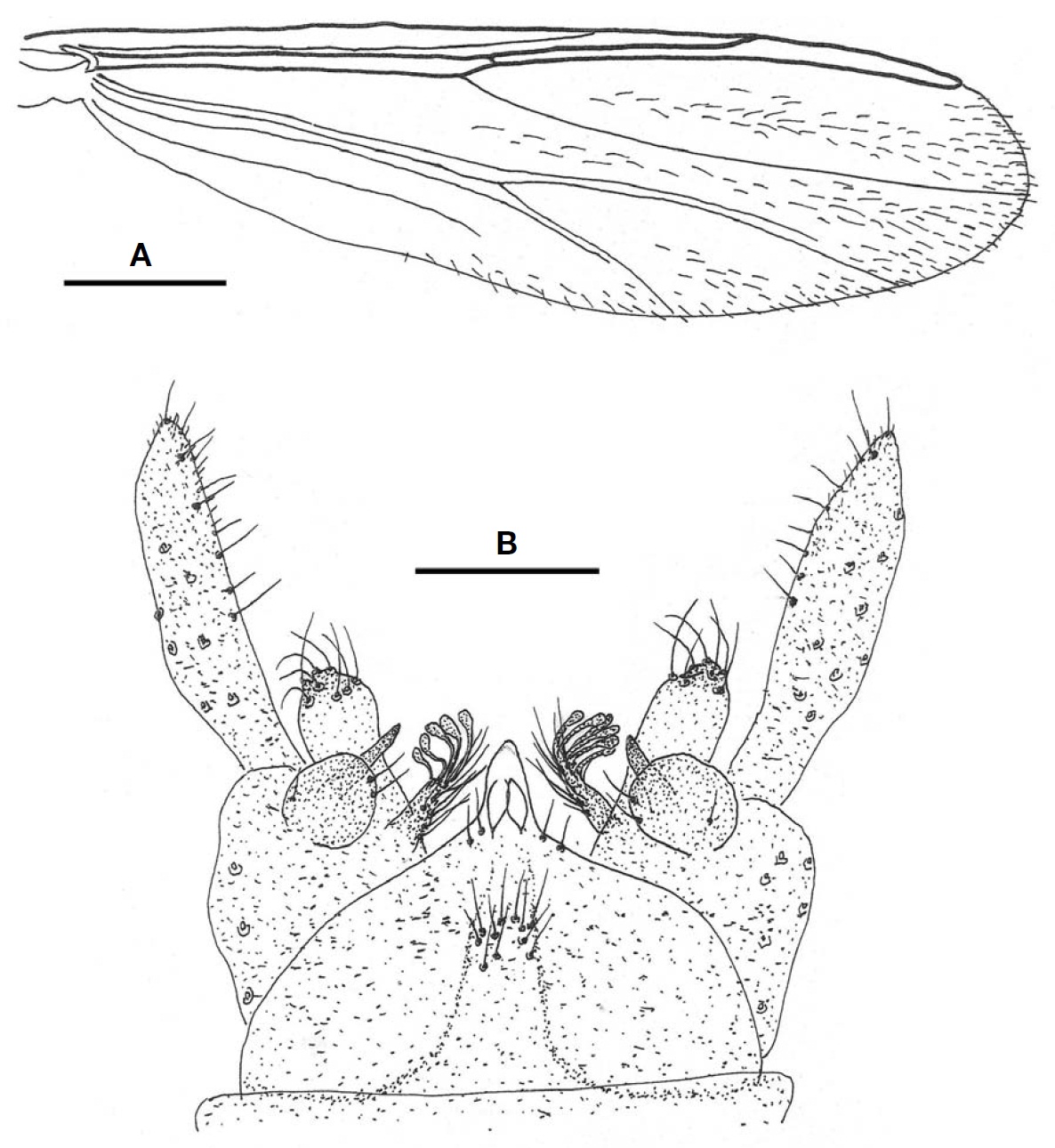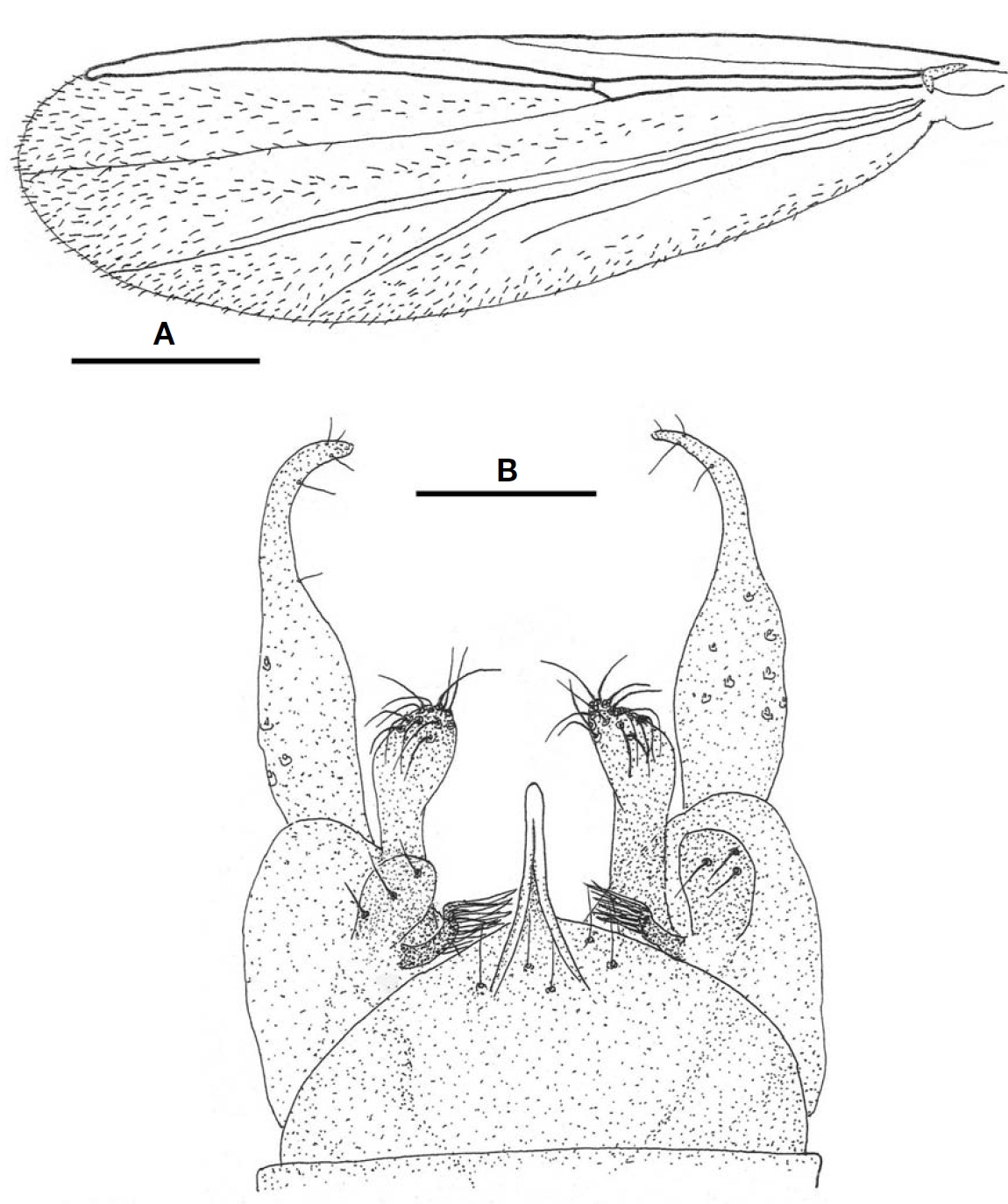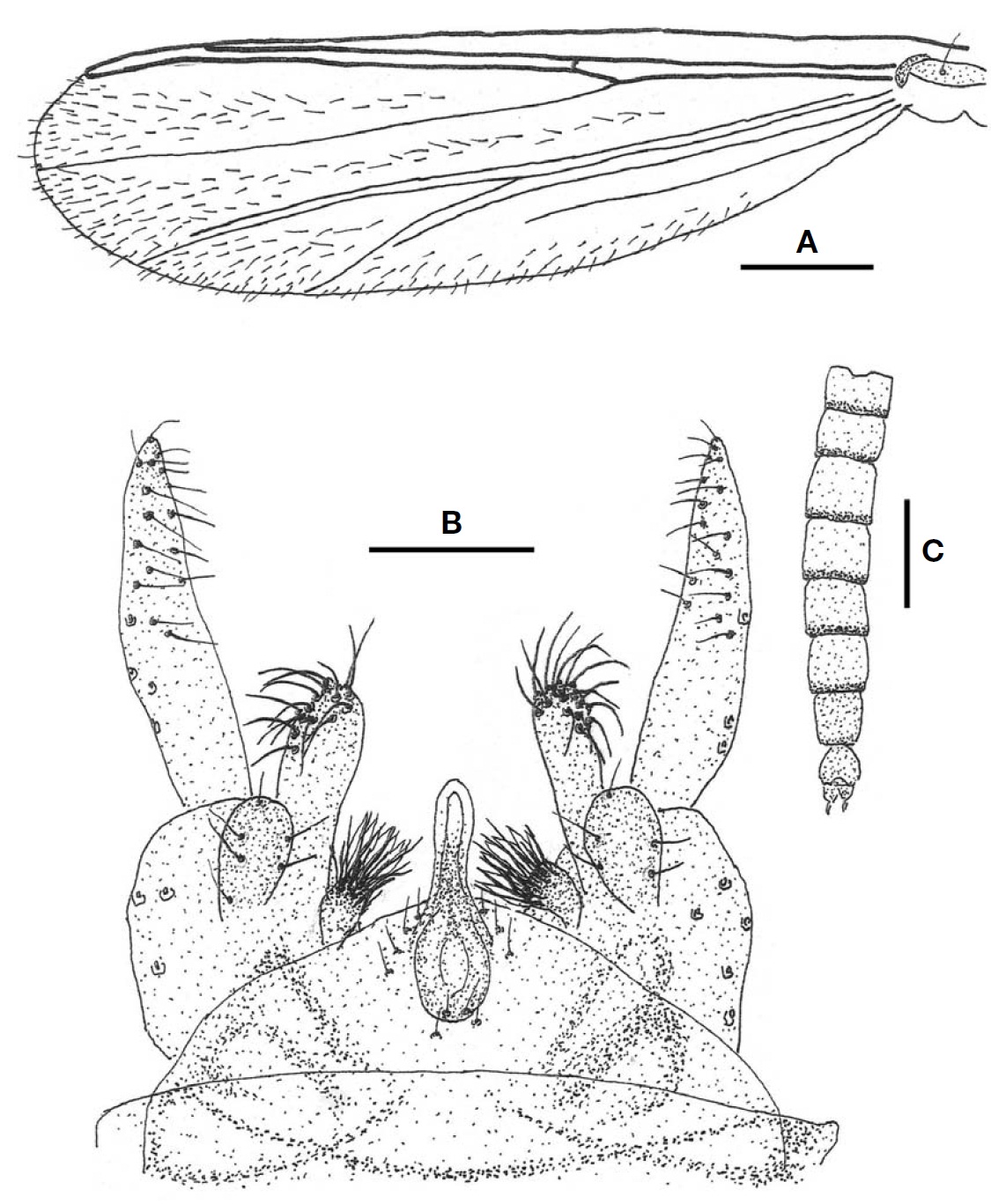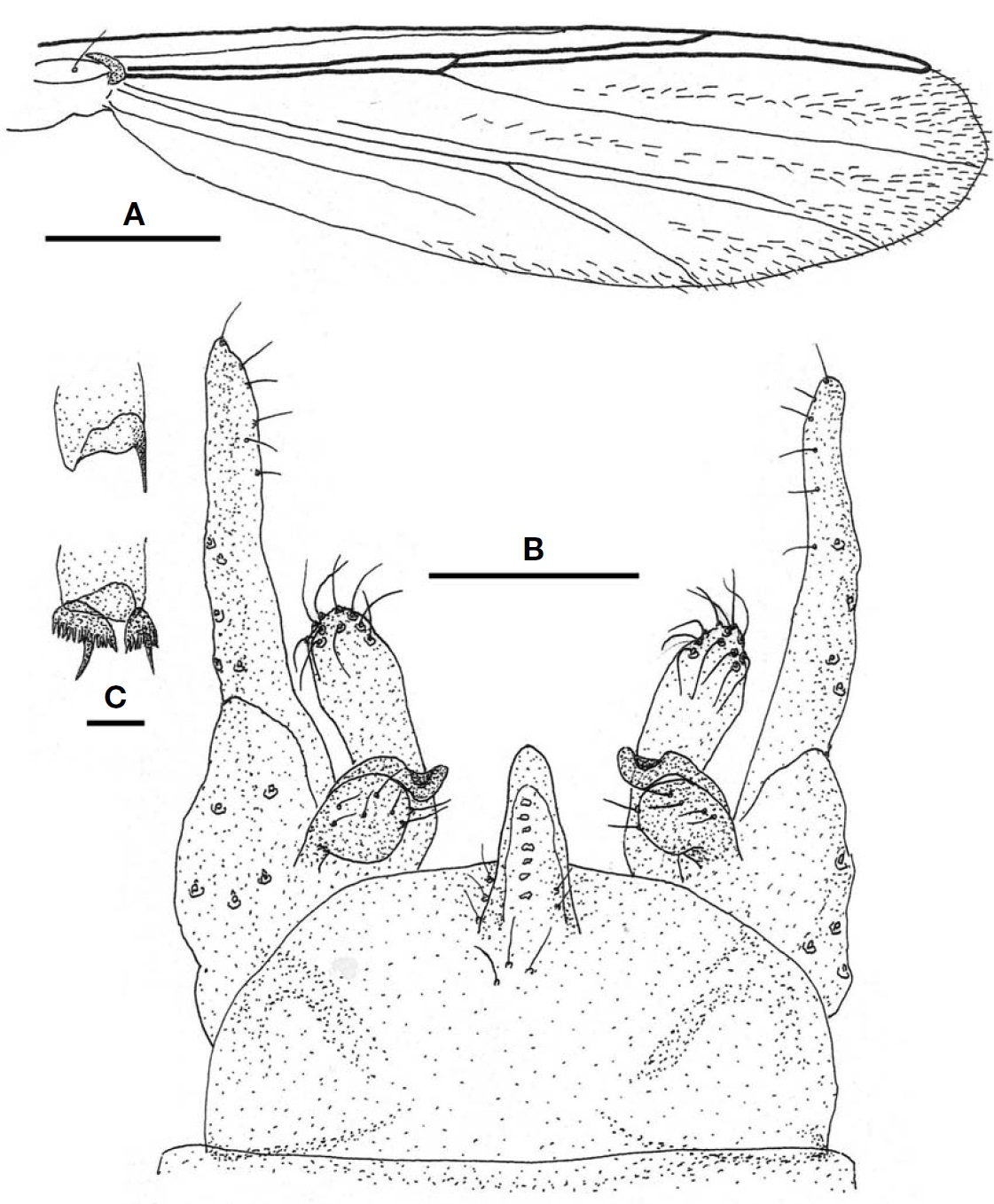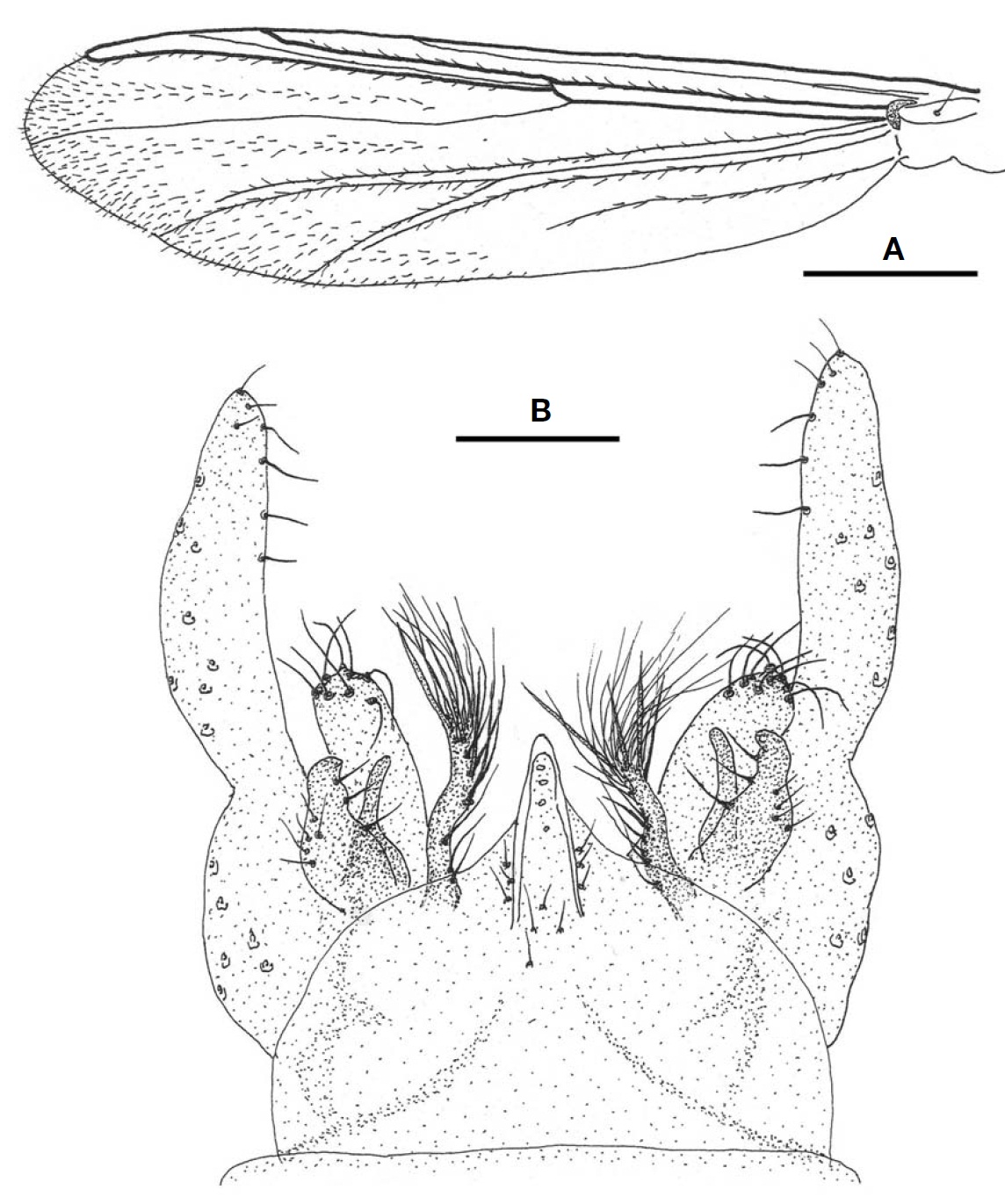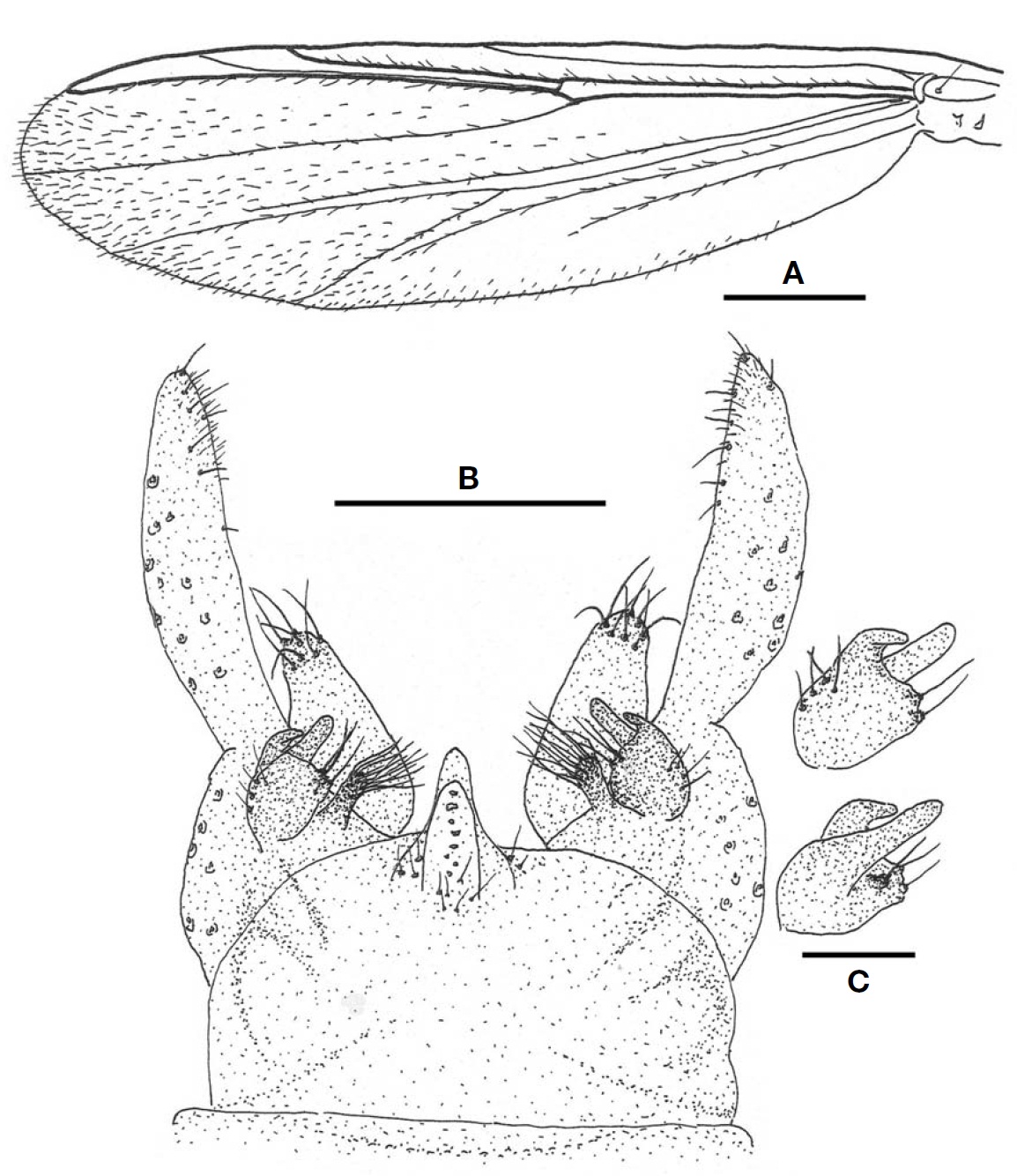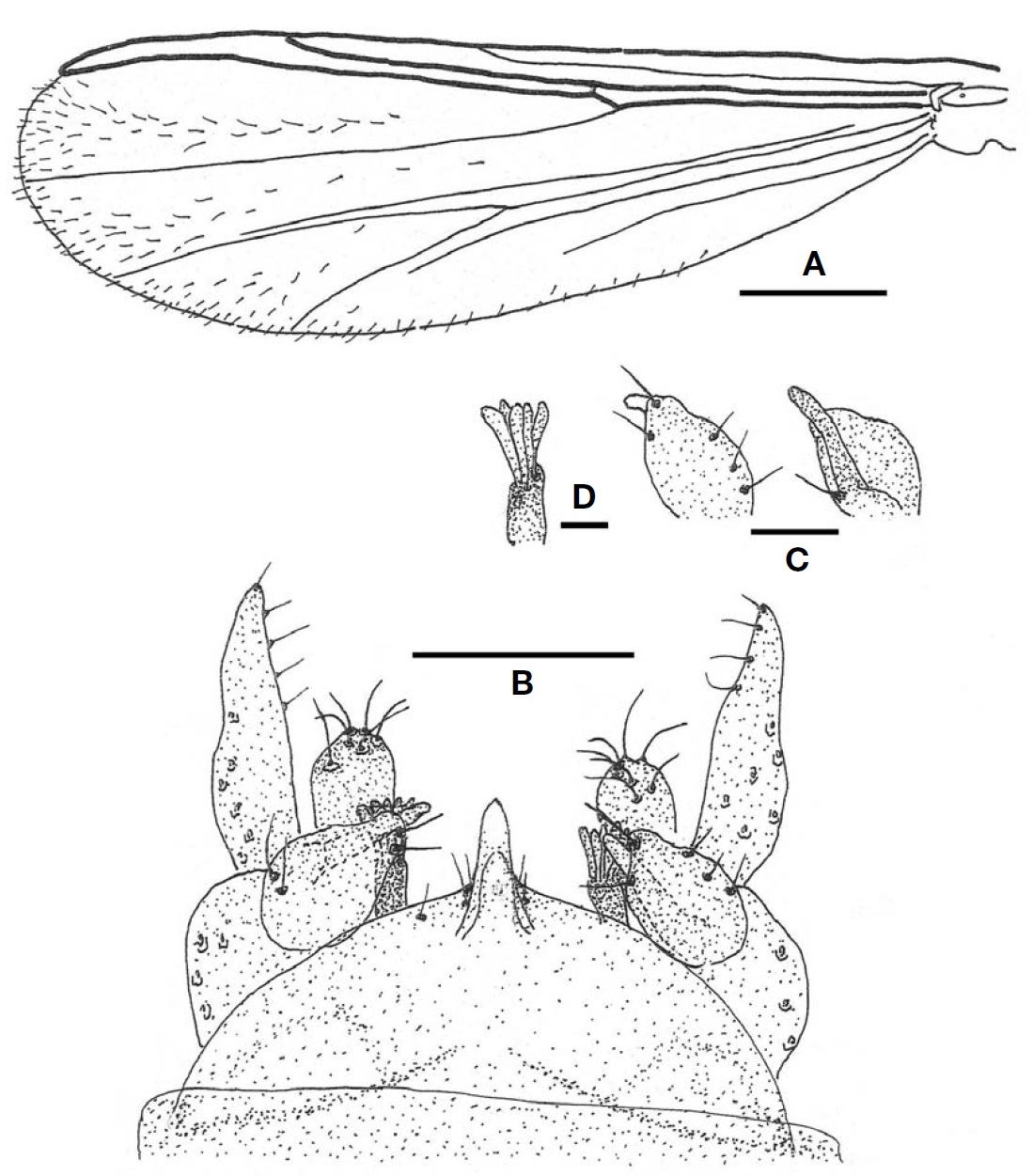



Adults of non-biting midges (Diptera, Chironomidae) were collected at Jeollabuk-do, Muju-gun, Muju-eup, Dangsan-ri on 5 September 2008, 22 May 2009 and 28 August 2009. Collection sites were near Namdae-stream which runs throu-gh the western area of Muju-eup. Chironomid adults attract-ed to the light sources of buildings such as restaurants, stores, police substation and the health center were aspirated by a suckling tube, and preserved in 75% ethanol. Later, they were dissected under stereomicroscope using fine needles to retri-eve antennae, head, wings and hypopygium, and were mount-ed on polyvinyl alcohol medium. They are presently fully des-cribed with illustrations. Chironominae is the largest sub-family among eight subfamilies of the family Chironomidae, and three tribes are recognized: Chironomini, Pseudochiro-nomini and Tanytarsini. The tribe Tanytarsini is characterized by wing with macrotrichia, squama bare, RM parallel to R4+5, and hypopygium with median volsella. In Korea, two species of Tanytarsini was reported for the first time by Ree and Kim (1988), one species by Ree (1989), two species by Ree (1992), one species by Ree and Kim (2003), four species by Na (2004), and seven species by Ree and Jeong (2010). Adding 10 species by the present paper, total 27 species of Tanytarsini are recorded. The type specimens have been de-posited in the collection of Arthropods of Medical Importance Resource Bank, Department of Environmental Medical Bio-logy, Yonsei University College of Medicine. Terminology follows that of Saether (1980).
Order Diptera
Family Chironomidae Haliday
Subfamily Chironominae Macquart
Tribe Tanytarsini
Genus Cladotanytarsus Kieffer, 1922
1*Cladotanytarsus neovanderwulpi sp. nov.
Material examined. Holotype, ♂ (R-CH-6987): Korea: Jeollabuk-do, Muju-gun, Muju-eup, Dangsan-ri, 28 Aug 2009, Jeong KY. Paratypes, 1♂ (R-CH-6463), locality and collector same as holotype, 2 Sep 2008; 6♂♂ (R-CH-7057, 7072, 7076, 7117, 7128, 7149), same as holotype.
Diagnosis. Small, yellowish species, with dark brown scutal vittae and postnotum. Wing length (WL) 1.1 mm. Eyes reni-form. Wing membrane with macrotrichiae on distal end only. Superior volsella, slightly tapered apically, tip bent up-ward, with 3-4 dorsal setae and 3 basal setae arised from cylindrical tube; digitus long. Median volsella short, with branched setae. Antennal ratio (AR) 0.73. Leg ratio (LR) 2.27.
Description (male). Head: Pale yellow. Eye bare, not dor-somedially produced. Frontal tubercle absent. Antenna pale dark brown, with 13 segments. AR 0.73. Clypeus pale yellow, with 9 setae. Palp pale, with 5 segments: 29, 32, 71, 125, 143 μm (1 : 1.1 : 2.5 : 4.3 : 4.9). Thorax: Pale yellow in ground color. Anteprotonum pale yellow, narrowed dorsal-ly, separated medially. Scutum overreaching antepronotum, with dark brown vittae. Scutellum dark brown, with 2 scu-tellars. Postnotum dark brown. Preepisternum dark brown. Halter pale yellow. Wing (Fig. 1A): WL 1.1 mm. Membrane with macrotrichiae only apically. R2+3 ending in proximal 1/3 between apices of R1 and R4+5. Only R4+5 with setae distal-ly. RM proximal to FCu. An scarcely reaching FCu. Anal lobe not developed. Squama bare. Arculus dark brown. Bra-chiolum pale, bare. Legs: All legs pale (foreleg slightly darker). Tibiae of mid and hind legs with separated combs, each with a spur. Pulvillus absent. LR 2.27. Abdomen: Uniformly pale yellow. Hypopygium (Fig. 1B): Anal tergite not apically produced, with 7-9 minute median setae, close to spines of anal point; anal tergite band pale and widely separated. Anal point partly overlying anal tergite, dully pointed apical-ly, with distinct crests and 6-9 irregularly directed spinules. Superior volsella slightly tapered apically, tip bent upward, with 3-4 dorsal setae and 3 basal setae arised from small cylindrical base; long digitus distinctly produced. Median volsella short, with branched lamellar setae. Inferior volsel-la cylindrical with 7-10 rather short setae, apical long seta ab-sent. Gonostylus rather short, small, with smoothly rounded apex.
Etymology. This new species is named for
Distribution. Korea (Muju).
Remarks. This new species is very similar to
1*Cladotanytarsus vanderwulpi (Edwards, 1929)
Material examined. 14♂♂, Korea: Jeollabuk-do, Muju-gun, Muju-eup, Dangsan-ri, 5 Sep 2008, Jeong KY, Nam SH.
Diagnosis. Small, pale yellow midge (WL 1.1 mm). Eye bare, without dorsomedial extension. Wing membrane with macrotrichiae on distal 1/3. Anal point short, conical, point-ed at tip, with anal crest and 4-5 spines. Superior volsella apically tapered, with 3-4 dorsal and 2 basal setae; digitus long, finger-like. Median volsella long, curved at middle, with branched setae. AR 0.74. LR 2.73.
Description (male). Head: Eye bare, not dorsomedially produced. Frontal tubercle absent. 10-11 postoculars each side. Antenna yellowish brown, with 13 segments. AR 0.74.Clypeus pale yellow, with 13 setae. Palp pale yellow, with 5 segments: 25, 25, 86, 93, 136 μm (1 : 1 : 3.4 : 3.7 : 5.4).
Thorax: Yellowish in ground color. Antepronotum pale yellow, bare, smoothly tapered dorsally, well separated each other. Scutum pale yellow, with brownish yellow vittae, 6-7 dorsocentals each side. Scutellum pale yellow, with 4 setae. Postnotum brownish yellow. Halter pale. Wing (Fig.2 A): WL 1.1 mm. Membrane with macrotrichiae on distal 1/3 only. R, R1, distal 1/2 of R4+5, distal 1/2 of M1+2 setosed. Costa not produced. R2+3 ending about on middle between ends of R1 and R4+5. RM well proximal to FCu. Cu1 almost straight. An scarcely reaching FCu. Anal lobe not develop-ed. Squama bare. Brachiolum pale, with 1 seta, arculus dark brown. Legs: all segments uniformly pale yellow. LR 2.73. Abdomen: Uniformly pale yellow. Hypopygium (Fig.2 B): Anal tergite with 4-5 small medium setae, 2-3 small apical setae on each side of anal point, and weakly developed apo-deme. Anal point short, conical, pointed at tip, with anal crest and 4-5 spine clusters. Superior volsella ovoid with short apical lobe, and 3-4 dorsal and 2 inner-basal setae; digitus long, narrow, finger-like. Median vosella long, curved at middle, with branched setae. Inferior volsella cylindrical with 8-11 rather short setae apically. Gonostylus rather short, smoothly rounded tip, with an apical and several sub-apical short setae.
Distribution. Europe (England), Mongolia, China, Japan, Korea.
Remarks.
Genus Paratanytarsus, Thienemann and Bause, 1913
1*Paratanytarsus inopertus (Walker, 1856)
Material examined. 12♂♂, Korea: Jeollabuk-do, Muju-gun, Muju-eup, Dangsan-ri, 22 May 2009, Jeong KY; 2♂♂, locality same, 28 Aug 2009, Jeong KY.
Diagnosis. Light brown, medium to small midge (WL 1.7 mm). Wing membrane heavily covered with macrotrichiae. Superior volsella round, with 9-10 dorsal setae; digitus point-ed at tip, slightly extending beyond margin of superior volsella. Median volsella moderately long, slightly curved at tip, with simple setae. Anal point short, flattened at tip, with unique anal crests. AR 1.22. LR 1.60.
Description (male). Head: Eye bare, with dorsomedial pro-jection. Frontal tubercle present (18 ㎛ long) (Fig.3 B). An-tenna pale dark brown, with 13 segments, AR 1.22. Palp pale yellow, with 4 segments: 30, 107, 107, 143 ㎛ (1 : 3.6 : 3.6 :
4.8). Clypeus pale yellow, with 15 setae. Thorax: Brownish yellow in ground color. Antepronotum brownish yellow, nar-rowed dorsally, widely separated each other. Scutum yel-lowish brown, remarkably overreaching antepronotum, vittae dark brown. Scutellum yellowish brown, with 9 setae. Post-notum dark brown. Prespisternum dark brown. Halter pale. Wing (Fig.3 A): WL 1.7 mm. Membrane covered with macrotrichiae. Costa not produced. R2+3 ending at 1/3 basal between ends of R1 and R4+5. RM proximal to FCu. An scarcely reaching FCu. Anal lobe not developed. Squama bare. Arculus pale, brachiolum pale with 1 seta. Legs: All segments uniformly yellowish dark brown. Fore tibia with a short apical spur; mid and hind tibial combs slightly separat-ed each other, each with a spur. LR 1.60. Pulvillus absent.
Abdomen: Uniformly pale yellow. Hypopygium (Fig.3 C): Anal tergite apically round, with 3-4 apical setae each side of anal point and 6 median setae; Anal tergite band V-type, almost reaching to base of anal point. Anal point short, flattened at tip, with unique anal crests. Superior volsella round, with 9-10 dorsal setae; digitus short, pointed at tip, only tip projecting beyond margin of superior volsella (Fig.3D). Median volsella moderately long (50 ㎛), slightly curved outward at tip, with many simple setae, directed out-ward.Inferior volsella cylindrical, with 14-16 setae at tip. Gonocoxite short. Gonostylus tapered apically, with an api-cal and several inner-lateral setae distally.
Distribution. Europe (England, France, Belgium), Mongo-lia, Japan, Korea.
Remarks.This species was reported in Europe (Edwards, 1929; Goetghebuer, 1937; Pinder, 1978) and Japan (Sasa and Kamimura, 1987). Sasa and Kamimura (1987) remarked that specimens collected in Japan was tentatively diagnosed as
1*Paratanytarsus paramikesecumdus sp. nov.
Material examined. Holotype, ♂ (R-CH-7432), Korea: Jeollabuk-do, Muju-gun, Muju-eup, Dangsan-ri, 22 May 2009, Jeong KY. Paratypes, 5♂♂ (R-CH-6502, 7315, 7364,7404, 7448), data same as holotype.
Diagnosis. Rather small, yellowish species (WL 1.4 mm). R2+3 absent. Anal tergite with 10-12 median setae on mid-dle. Anal point short, rounded at tip, with a scale-like ridges. Superior volsella round, with 2 inner-marginal setae and 1 dorsal seta; digitus slightly pointed, long projecting beyond margin of superior volsella. Median volsella short, with 5-6 spoon-shaped setae and several simple setae. AR 0.95. LR 1.70.
Description (male). Head: Eye bare, with moderately pro-duced dorsomedial extension. Frontal tubercle absent. 7-8 postoculars. Antenna brownish yellow, with 13 segments, AR 0.95. Palp pale, with 5 segments: 30, 36, 91, 104, 143㎛ (1 : 1.2 : 3.0 : 3.5 : 4.8). Clypeus pale yellow, with 15 setae. Thorax: Yellow in ground color. Antepronotum yel-lowish, narrowed dorsally, widely separated. Scutum over-reaching antepronotum, light yellow, vittae absent. Scutel-lum yellow, with 3 setae. Postnotum yellow. Halter pale.
Wing (Fig.4 A): WL 1.4 mm. Membrane covered with macrotrichiae, mostly on distal half. Costa not produced, R1 and R4+5 running closed each other. R2+3 absent. FCu slight-ly distal to RM. Cu1 almost straight. An just reaches FCu. Anal lobe not developed. Squama bare. Arculus pale, bra-chiolum pale, with 1 seta. All veins, except subcosta and M, setosed. Legs: All segments uniformly pale yellow. Fore tibia with a weak spur apically; mid and hind tibial combs narrowly separated, each with a short spur. Pulvillus absent. LR 1.70. Abdomen: Uniformly pale yellow. Hypopygium (Fig.4 B): Anal tergite with 10-12 median setae and 2-3 apical setae each side of anal point. Anal point short, round-ed at tip, with a pair of scale-like ridges. Superior volsella round, with 2 innerlateral setae and 1 outer-lateral seta; digi-tus long, projecting beyond margin of superior volsella. Me-dian volsella short, with spoon-shaped setae. Inferior volsel-la cylindrical, slightly bulbous at tip, with 7-9 comparatively short setae. Gonostylus tapered apically, with 10-12 short setae along inner margin, arised irregularly.
Etymology. The new species name refers to
Distribution. Korea (Muju).
Remarks. This species is very close to
Genus Rheotanytarsus Bause, 1914
2* Rheotanytarsus parapentapodus sp. nov.
Material examined. Holotype, ♂ (R-CH-6429), Korea: Jeollabuk-do, Muju-gun, Muju-eup, Dangsan-ri, 28 Aug 2009, Jeong KY. Paratypes, 6♂♂ (R-CH-6420, 6421, 6455, 6465, 6974, 7143), same as holotype.
Diagnosis. Small, pale yellow species (WL 1.4 mm). Superior volsella round, with 3 dorsal setae; digitus absent. Median volsella short, abruptly curbed at tip, directed inward, with both lamellated and simple setae. Gonostylus abruptly nar-rowed and curbed apically. AR 0.86. LR 2.80.
Description (male). Head: Pale yellow. Eye bare, dorso-medially produced. Frontal tubercle absent. Antenna pale, yellowish brown, with 13 segments. AR 0.86. Palp pale yellow, with 5 segments: 36, 36, 121, 130, 211 ㎛ (1 : 1 :3.4 : 3.6 : 5.9). Clypeus pale yellow, with 15 setae. Thorax: Pale yellow in ground color. Antepronotum pale yellow, nar-rowed dorsally, widely separated. Scutum pale yellow, vittae absent, 16 acrosticals, 7-8 dorsocentrals and 1 prealar each side. Scutellum pale, with 7 setae. Postnotum pale yellow. Halter pale. Wing (Fig.5 A): WL 1.4 mm. Wing membrane with macrotrichiae all over, denser distally. Costa not pro-duced. R4+5 lying very close to R1. R2+3 absent. RM well pro-ximal to FCu Anal lobe not developed. Brachiolum pale; arculus yellowish brown. All veins setosed. Squama bare. Legs: All segments pale yellow. Fore tibia with a pale slen-der spur apically; mid and hind tibiae with separated combs,each with a spur. Pulvillus absent. LR 2.80. Abdomen: Pale yellow. Hypopygium (Fig.5 B): Anal tergite round distally, with several apical setae; anal tergal band poorly developed. Anal point rather long, slender, with well developed anal crests. Superior volsella round, with 3 setae dorsally; digitus absent. Median volsella short, abruptly curved at tip, direct-
ed inward, with both lamellar and single setae at tip. Infe-rior volsella rather long, cylindrical, with 14-17 setae. Gono-stylus abruptly narrowed in distal 1/2, bent inward apically.
Etymology. The new species is named after
Distribution. Korea (Muju).
Remarks.This new species is very similar to
1*Rheotanytarsus sungili sp. nov.
Material examined. Holotype, 1♂ (R-CH-7396), Korea: Jeollabuk-do, Muju-gun, Muju-eup, Dangsan-ri, 22 May 2009, Jeong KY.
Diagnosis. Small to medium, pale yellow midges (WL 1.65 mm). R2+3 absent. Abdominal tergite pale, with dark, narrow apical band. Anal point moderately long, slightly constrict-ed at middle, with circular anal crest (doughnut form) at base of anal point. Superior volsella ovoid; digitus absent. Median volsella short, with lamellar and simple setae. AR 0.94. LR 2.09.
Description (male). Head: Eye bar, with well developed dorsomedial extension. Frontal tubercle absent. 6-8 posto-culars each side. Antenna yellowish brown, with 13 segments; AR 0.94. Palp pale yellow, with 5 segments: 32, 36, 118,118, 189 ㎛ (1 : 1.1 : 3.7 : 3.7 : 5.9). Clypeus pale yellow, with 18 setae. Thorax: Greenish pale yellow in ground color. Antepronotum pale yellow, narrowed dorsally, widely sepa-rated. Scutum overreaching antepronotum, with vandike brown vittae; 16 acrosticals, 8 dorsocentrals and 1 prealar each side. Scutellum pale yellow, with 7 setae. Postnotum vandike brown. Wing (Fig.6 A): WL 1.65 mm. Membrane with macrotrichiae, more densely on distal 1/3. Costa not extended. R4+5 running very close to R1. R2+3 absent. End of R4+5 distal to end of M3+4. RM well proximal to FCu. An scarcely reaching FCu. Anal lobe not developed. Squama bare. Arculus dark brown; brachiolum pale brown, with 1 seta. Legs: All femora pale yellow, with dark brown apical end. Tibia and tarsi of foreleg pale yellowish brown; tibia and tarsi of mid and hind legs pale yellow. Fore tibia with an apical spur. Pulvillus absent. LR 2.09. Abdomen: Ter-gite I-VI pale, with dark apical band (Fig.6 C); tergite VII-VIII pale, without dark band. Hypopygium (Fig.6 B): Anal tergite moderately produced apically; anal tergal band almost horizontal, widely separated; coxapodeme, phallapodeme, transverse sternapodeme well developed. Anal point mode-rately long, slightly constricted at middle, tip smoothly round-ed, with circular anal crest (doughnut-like) at the base of anal point. Superior volsella ovoid, with 5-6 dorsal setae; digitus absent. Median volsella very short, with both lamellar and simple setae. Inferior volsella cylindrical, with 15-18 setae apically. Gonocoxite comparatively large. Gonosty-lus smoothly tapered distally, with many irregularly arrang-ed setae on distal half.
Etymology.The new species is named after Mr. Sungil Jeong who was a police officer at Muju before his death in 2007.
Distribution. Korea (Muju).
Remarks. A unique character of this species is the circular (doughnut form) crest of the anal point. Only
Genus Tanytarsus v.d. Wulp, 1874
2*Tanytarsus neotamaoctavus sp. nov.
Material examined. Holotype, ♂ (CH-6758), Korea: Jeol-labuk-do, Muju-gun, Muju-eup, Dangsan-ri, 22 May 2009, Jeong KY. Paratypes, 12♂♂ (CH-6701, 6763, 6811, 6817,6828, 6835, 6857, 6861, 6880, 6881, 6905, 7354), data same as holotype; 4♂♂ (CH-7301, 7311, 7313, 7321), locality same, 8 Aug 2009, Jeong KY.
Diagnosis. Medium to small, yellowish midge (WL 1.5 mm). R1 and R4+5 running close, and R2+3 absent. Anal point smoothly tapered apically, with well defined crest and 7-8 spinules. Superior volsella round, with upwardly twisted api-cal lobe; digitus absent. Gonostylus narrow. AR 0.82. LR 2.51.
Description (male). Head: Yellowish. Eye bare, slightly pro-duced dorsomedially. Frontal tubercle absent. 8-10 posto-culars. Antenna pale brown, with 13 segments. AR 0.82. Cly-peus pale yellow, with 13 setae. Palp pale, with 5 segments: 31, 31, 112, 110, 153 ㎛ (1 : 1 : 3.7 : 3.6 : 5.0). Thorax: Deep yellow in ground color. Antepronotum light yellow, lobes separated medially. Scutum overreaching anteprono-tum, brownish yellow vittae not clearly defined. Scutellum pale, with 3 setae. Postnotum brownish yellow. Halter pale.
Wing (Fig.7 A): WL 1.5 mm. Membrane covered with macrotrichiae mostly on the distal half. All veins setosed, except subcosta and R. R1 and R4+5 running closed. R2+3 absent. RM proximal to FCu. Cu1 almost straight. Anal lobe not developed. Squama bare. Arculus dark brown, brachio-lum pale, with 1 seta. Legs: Uniformly pale yellow. Fore tibia with an apical spur; mid and hind tibial combs widely separated, each with a spur (Fig.7 C). Pulvillus not develop-ed. LR 2.51. Abdomen: Uniformly pale yellow. Hypopy-gium (Fig.7 B): Anal tergite pale yellow, weakly developed and tergite band widely separated, with 3-4 short median setae and 2-3 apical setae each side of anal point. Anal point smoothly tapered apically, with round apex, and with well defined anal crest and 7-8 groups of spines. Superior volsel-la round, with upwardly twisted apical lobe, with 3 inner-
lateral and 4-5 dorsal setae. Digitus absent. Median volsella absent. Inferior volsella cylindrical, slightly clubbed at tip, with 9-11 rather short setae. Gonostylus narrow, with an api-cal and 4-5 inner-lateral short setae.
Etymology. This species name refers to closely related spe-cies
Distribution. Korea (Muju).
Remarks. This new species is extremely similar to
species and 0.65 in the latter, (3) the gonostylus is more slen-der in the former, and (4) R2+3 is absent in our specimens (Sasa, 1980). Na (2004) collected 10 specimens of
1*Tanytarsus synyunosecundus sp. nov.
Material examined. Holotype, ♂ (R-CH-6716), Korea: Jeollabuk-do, Muju-gun, Muju-eup, Dangsan-ri, 5 Sep 2008, Jeong KY, Nam SH. Paratypes, 8♂♂ (R-CH-6447, 6611,6619, 6630, 6749, 6829, 6882, 6883), locality same, 22 May
2009, Jeong KY; 4♂♂ (R-CH-6953, 7000, 7051, 7237), locality same, 28 Aug 2009, Jeong KY.
Diagnosis. Medium to small, pale yellow midge (WL 1.4 mm). Anal point largely overlying anal tergite, smoothly tapered apically, with well defined crest and 4-5 spine clus-ters. Superior volsella oval, elongated apically; digitus long, finger-like, projecting well beyond margin of superior volsel-la. Median volsella long, slightly curved, with many long, simple setae. AR 1.07. LR 3.16.
Description (male). Head: Eye bare, with short dorsome-dial projection. Frontal tubercle moderately developed (18㎛ long×15 ㎛ wide). Antenna yellowish brown, with 13 segments. AR 1.07. Palp pale, with 5 segments: 32, 6, 114,107, 179 ㎛ (1 : 1.1 : 3.6 : 3.4 : 5.6). Clypeus pale yellow,with 15 setae. Thorax: Uniformly pale yellow. Antepronot-um wide, dorsomedially separated. Scutum without vittae; 8 dorsocentrals and 1 prealar each side. Scutellum pale, with 5 setae. Postnotum pale yellow. Halter pale. Wing (Fig.8 A): WL 1.4 mm. Membrane with macrotrichiae on distal half. All veins setose, except R. Costa not produced. R2+3 weakly developed, ending at middle between apices of R1 and R4+5. RM proximal to FCu. Cu1 almost straight. Anal lobe not developed. Squama bare. Arculus dark brown, brachiolum pale, with 1 seta. Legs: Uniformly pale yellow. Fore tibia with an apical spur; mid and hind tibial combs narrowly separated, each with a spur. Pulvillus absent. LR 3.16. Abdo-men: All segments pale yellow. Hypopygium (Fig.8 B): Anal tergite roundly produced distally; anal tergite band poorly developed, widely separated each other; 4-5 minute median setae. Anal point largely overlying anal tergite, smoothly tapered apically; tip round, with strong crest and 4-5 spines. Superior volsella oval, elongated apically, with 3 inner-lateral and 4-5 dorso-lateral setae; digitus finger-like, projecting well beyond margin of superior volsella. Median volsella very long, with numerous long, simple setae. Inferior volsella cylindrical, with 8-9 apical setae. Gonosty-lus rather long, slightly curved at base, fused with gonocoxite, with an apical and 4-5 inner-lateral setae.
Etymology. The name
Distribution. Korea (Muju).
Remarks. Most characters of this new species coincided well with those of
1*Tanytarsus tamagotoi Sasa, 1983
Material examined. 2♂♂, Korea: Jeollabuk-do, Muju-gun, Muju-eup, Dangsan-ri, 5 Sep 2008, Jeong KY, Nam SH; 5♂♂, locality same, 22 May 2009, Jeong KY; 3♂♂, locality same, 28 Aug 2009, Jeong KY.
Diagnosis. Medium to small, yellowish midge (WL 1.88 mm). Anal point abruptly widened at base, with round tip,well defined crest and 5-7 spine clusters. Superior volsella ovoid, with small apical lobe, and 3 inner-lateral and 4-5 outer-lateral setae dorsally, and 1 ventral seta arising from cylindrical base; digitus long, finger-like. Median volsella short, with numerous simple setae. Gonostylus fused with gonocoxite. AR 1.16. LR 2.61.
Description (male). Head: Eye bare, slightly produced dor-somedially.10-12 postoculars. Frontal tubercle absent. Anten-na dark brown, with 13 segments, AR 1.16. Palp pale, with 5 segments: 36, 36, 107, 118, 143 ㎛ (1 : 1 : 3.0 : 3.3 : 4.0). Clypeus pale yellow, with 12 setae. Thorax: Yellow in ground color. Antepronotum yellow, dorsally narrowed, separated dorsomedially. Scutum overreaching anteprono-tum, vittae absent. Scutellum pale yellow, with 3 setae. Post-notum yellow. Wing (Fig.9 A): WL 1.88 mm. Membrane with macrotrichiae, mostly on distal half. Costa not produc-ed. R2+3 running close to R4+5 and ending at 1/3 basal bet-ween ends of R1 and R4+5. RM proximal to FCu. Cu1 almost straight. Anal lobe not developed. Squama bare. Arculus pale yellow, brachiolum pale, with 1 seta. Legs: All segments uniformly pale yellow. Foretibia with 1 spur apically; mid and hind tibial combs separated, each with 1 spur. Pulvillus absent. LR 2.61. Abdomen: Uniformly pale yellow. Hypo-pygium (Fig.9 B): Anal tergite smoothly rounded distally, poorly developed anal tergite band widely separated; apo-deme weakly developed. Anal point widened at base, with round tip, and well developed crest and 5-7 spine clusters. Superior volsella somewhat ovoid, with a small, apical lobe curved inward at tip, with 2-3 inner-lateral and 4-5 outer-lateral setae dorsally, and 1 ventral seta arising from cylind-rical base; digitus long, finger-like, well projecting margin of superior volsella (Fig.9 C). Median volsella short, with numerous simple setae. Inferior volsella cylindrical, convex at base internally, with 7-9 erect setae at tip. Gonostylus fused with gonocoxite, inner margin almost straight, with an apical, several setae and numerous microtrichiae distally.
Distribution. Japan and Korea.
Remarks. Our specimens coincide well with
2*Tanytarsus uresiacutus Sasa, 1989
Material examined. 6♂♂, Korea: Jeollabuk-do, Muju-gun, Muju-eup, Dangsan-ri, 5 Sep 2008, Jeong KY, Nam SH; 2♂♂, locality same, 28 Aug 2009, Jeong KY.
Diagnosis. Small, right yellow species (WL 1.2 mm). Anal
point rather small, tapered at tip, with distinct anal crest; anal spines absent. Superior volsella ovoid, with 4-5 minute setae dorsally; finger-like digitus projecting beyond margin of superior volsella. Median volsella short, directed back-ward, with 5-7 spoon-shaped lamellar setae. Gonostylus rather small, tapered apically. AR 0.73. LR 2.42.
Description (male). Head: Eye bare, dorsomedially extend-ed. Antenna yellowish brown, with 13 segments, AR 0.73. Frontal tubercle absent. Clypeus pale yellow, with 13 setae.Palp pale, with 5 segments: 27, 28, 77, 90, 115 ㎛(1 : 1.0 :2.9 : 3.3 : 4.3). Thorax: Light yellow in ground color. Ante-pronotum pale yellow, narrowed dorsally, medially separat-ed each other. Scutum light yellow, vittae absent. Scutellum pale yellow, with 4 scutellars. Postnotum pale yellow. Wing (Fig.10 A): WL 1.2 mm. Membrane with macrotrichiae on distal half. Costa not produced. R2+3 absent. R4+5 lying close to R1. RM well proximal to FCu. Anal lobe not developed. Brachiolum and arculus pale. Squama bare. Legs: All legs
uniformly pale yellow. Fore tibia with a short spur; mid and hind tibial combs separate, with only one spur. Puvillus not developed. LR 2.42. Abdomen: Uniformly pale yellow. Hypopygium (Fig.10 B): Anal tergite smoothly rounded apically; anal tergite band and apodeme poorly developed; median setae absent. Anal point rather short, tapered at tip, with distinct anal crest distinct; anal spines absent. Superior volsella (Fig.10 C) ovoid, with 4-5 minute setae dorsally;finger-like digitus projecting slightly beyond margin of supe-rior volsella. Median volsella (Fig.10 D) short, directed back-ward, with 5-7 spoon-shaped lamellar settae. Inferior volsel-la cylindrical, with 6-8 rather short setae apically. Gonosty-lus rather small, tapered apiclly, with 1 apical and 5-6 inner-lateral setae.
Distribution. Japan and Korea.
Remarks. Sasa (1989) described a new species,
Korean name: 1*신울프눈장부깔따구 Korean name: 1*울프눈장부깔따구 Korean name: 1*구슬옆장부깔따구 Korean name: 1*고사리옆장부깔따구, 2*집게유장부깔따구 Korean name: 1*성일유장부깔따구, 2*꼬부랑장부깔따구 Korean name: 1*말꼬리장부깔따구 Korean name: 1*가위장부깔따구, 2*즐거워장부깔따구
